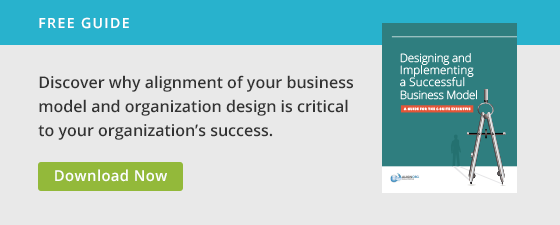One of the biggest stumbling blocks that we regularly see in organization transformations includes thinking that we need to speed through an organization design to get back to the “real” work of the organization. Although the benefits of true organization transformation are great, the reality is that it takes time, energy, and alignment leadership to make true transformation happen.
When we talk about the time, resources, and mindset necessary for organization change, there are two related, yet different conversations worth having:
- What are the necessary change activities that leaders need to drive?
- How do we dedicate the resources needed to drive change while keeping the day-to-day work of the organization happening?
The first issue centers around alignment leadership. Some leaders see redesigning their organization and aligning activities as a distraction from the “daily hum” of work. As the owners of the company’s strategy, one of the most critical roles for leaders is to create the conditions for the organization to achieve market growth. Leaders are directly responsible for architecting and driving the design of the organization forward to fully reap the rewards of strategy. As alignment leaders, this is their “real work.”
More specifically, alignment leaders champion a number of change activities including conducting design sessions, identifying project leads/managers, monitoring and assessing organizational health, and orchestrating implementation activities. A leader’s commitment to these activities will set the tone and help drive the change throughout the organization. Without the right level of sponsorship, these activities languish and rarely lead to true organization change.
The second issue assumes that leaders have committed their influence and time to the work, have involved others, and now need to figure out how to enlist the resources necessary to see the change through.
I was recently involved with an organization in the beginning stages of implementing an organization transformation effort. The leaders had done a great job championing the work and involving the right people to cascade the message and understanding of the strategy throughout the organization. As we began to assign change management tasks at a more detailed level, some of the team members began to express concern about how they would get all of their daily work done and drive the important transformation objectives. Although they were committed to the transformation and thought that it was the right direction for the organization, they were unsure how to balance all of the work that needed to be done.
This is a very common scenario, and leaders need to understand both the amount of work necessary to make a change happen as well as how to help those involved in the change manage their time in a way to prevent burn out or “brown out” (slowly disengaging from the work due to a constant state of overwork). The following can be helpful as you add change activities to what is often already a full schedule for key team members:
- Lighten the Plate. Think of your team members’ capacity like a dinner plate – it can hold a lot of food, but at some point it will be full. When you start with a fairly full plate of daily operational tasks and then add a helping of design, change management, and/or implementation activities, some things are going to fall off the plate. Rather than keep cycling the things that fall off the plate back on and therefore push something else off, realize the limits of your team members and find another way to address the work that doesn’t fit. This might mean shifting activities to an employee who reports to you who has capacity. Maybe you can spread those activities to multiple team members in your organization. Maybe you can stop or delay some work until the capacity exists to take it on properly. The bottom line is that you can only put so much on team members’ plates.
- Allow Others to Step Up. Some leaders may worry about pushing some of “their” activities onto others’ plates or freeing up an employee entirely to participate in some aspect of the transformation work. Rather than see this activity relocation and/or backfilling as a “burden,” instead see it as an opportunity for high-potential employees to step up, learn, and grow. Trusting team members to lead transformational activities will create capacity and provide opportunities for team members to gain the skills needed for future leadership responsibilities.
- Focus on Skills. Whether it is a manager working on design or backfilling a resource to focus more on transition activities, clearly communicate how the experience and work will develop them personally. Design work and new responsibilities can help employees grow, develop, or enhance their skills (organizational, communication, public speaking, project management, change management, strategic thinking, etc.). Team members are often more willing to take on “stretching” assignments and increase their workload when they can see how the work will help them grow their skills and career.
- Stick to a Deadline. An increased workload that lasts indefinitely can be a recipe for disengagement and discouragement. To help with this, provide a deadline for their contribution and stick to it! Having a light at the end of the tunnel can be extremely helpful to combat fatigue and burnout.
- Transparency. Rather than just telling leaders and managers what you want them to do, explain why. Give them the big picture of the strategy and design and remind them often. Regular updates and constant sharing of the future vision gives people a reason to buy-in and add work to their already full plates and increase their investment into the future of the organization.
- Crunch the Numbers. At a certain level, you need to evaluate whether you have enough people for additional change activities (even in spite of the suggestions above). If you simply don’t have the resources, you might need to consider outsourcing some of your everyday work to free up key employees. Maybe you can backfill positions with a mix of internal and external staff. After you have a clear understanding of the amount of work that will need to be done, you can begin to evaluate your capacity and needs.
- Consider a Transformation Specialist. Does your organization have the internal skills to lead the transition and the related activities? If not, you might consider a change transformation specialist who can coach leaders, facilitate design sessions, integrate change management activities, plan and execute communications, analyze the change politics, and drive execution activities. Having a person with experience who can help you see around the corners can prove invaluable in a transformation.
While an organization change will inevitably mean more work for your organization, having the right level of leader sponsorship and implementing one or more of the seven resourcing methods outlined above can certainly help you successfully implement transformational change.






